Information and Exercise Leaflet for
Patients and Carers
This condition is commonly known as tennis elbow. Pain is felt on the outer part of the elbow and is often tender to touch. Activities which involve moving the wrist backwards or upwards may increase or cause the pain. Sometimes gripping objects can be painful too.
The Elbow
The elbow is a hinge joint between the upper arm bone (humerus) and the forearm bones (radius and ulna). A bony prominence can be felt on each side of the elbow and this is where the muscles of the forearm attach.
Muscles which straighten your fingers and lift the wrist up merge into one tendon (common extensor origin) which, attaches to the bony lump on the outside of the elbow. Pain is commonly caused by gripping and twisting activities such as wringing out clothes or using a screwdriver.
Causes
The exact cause of tennis elbow is not known, but it does tend to occur after repetitive use of the extensor tendons at the elbow. Repeated movements are thought to cause microscopic tears in the tendon and begin to cause degeneration and pain. Tests on the tendon have proved that this is not an inflammatory process.
How is it diagnosed?
A few simple clinical tests of movement and strength can tell us what the problem is. It is not necessary to have an x-ray or scan to diagnose the problem. Occasionally an x-ray will be needed if we think you might have another underlying problem for example, osteoarthritis.
What treatments are available?
In the first instance you will be offered conservative (non-operative) management which includes advice, pain relief medication, activity modification and physiotherapy including exercise-based therapy.
Very rarely an injection will be offered if these fail to help.
Surgical management is a last resort and is only considered in few cases.
Evidence from research trials show that most patients following this regime will be better within 12 months
Advice
Try to minimise the activities which cause your pain. Try to lift with your palm facing upwards which will reduce strain through the painful muscles and tendon.
Pain Relief
Your GP or Pharmacist can advise you on the most appropriate medications to take. Remember it is usually better to take a simple low dose pain killer (e.g. paracetamol) regularly rather than to wait until the pain is bad. Your GP or Pharmacist may recommend you to use an anti-inflammatory gel for the first 2-4 weeks.
Physiotherapy
Evidence from research trials show that physiotherapy can give pain relief more quickly than waiting for the symptoms to improve. Most patients will be pain free within 12 months. The physiotherapy programme that is effective consists of a graded stretching and exercise programme. It takes several months for the benefit to be felt so it is important to persevere.
Injection
Evidence shows us that although steroid injections help to relieve the pain, they are often only effective in the short term. In the long-term, the pain can return and then be more difficult to relieve. Within 12 months, 72% of patients who had an injection had a reoccurrence of their symptoms. It is important that you think carefully about having an injection. It may be good in the short-term but then you may have more problems later.
Surgery
This involves releasing the tendon and is usually a keyhole operation. About 70% of patients improve with this type of procedure but some people are no better and a few worse. Risks include bleeding, infection, nerve damage, a painful scar and weakness. Surgery is the last resort and will only be considered after a lengthy course of conservative management.
Exercise Programme
The aim of these exercises is to help regain strength, flexibility and normal movement.
Complete 2 - 3 times per day.
How do I know if my activities are causing a painful reaction?
It is common to get a painful reaction if too much load is put through the elbow. If this pain is more than 5/10 (with 10 being the worst pain imaginable) and lasts for more than 24 hours, check what you have been doing and ease back.
Once this has settled you can start to gradually reintroduce your activities and exercises. If you have a mild aggravation (pain is less than 5/10) and this settles within 24 hours, then keep going with your exercises and gradual return to full activities.
Exercise 1 - Clenching fist strongly
Clench fist strongly and release.
- You can clench the fist around a ball or use a hand grip strengthener.
- Repeat 10 times.
- Build up to 3 sets of 10.
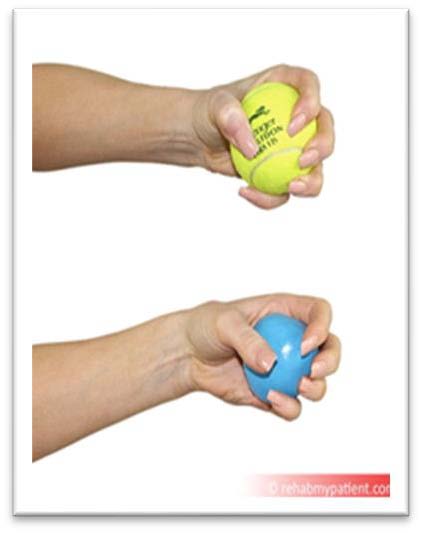
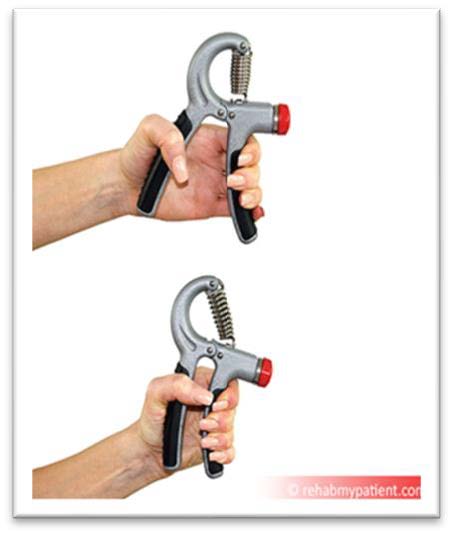
Exercise 2 - Resist extending the wrist
Resist extending the wrist.
- You can do this by placing your affected hand in front of you, and resist the movement of your hand upwards.
- Your wrist should not move.
- Repeat 10 times.
- Build up to 3 sets of 10.
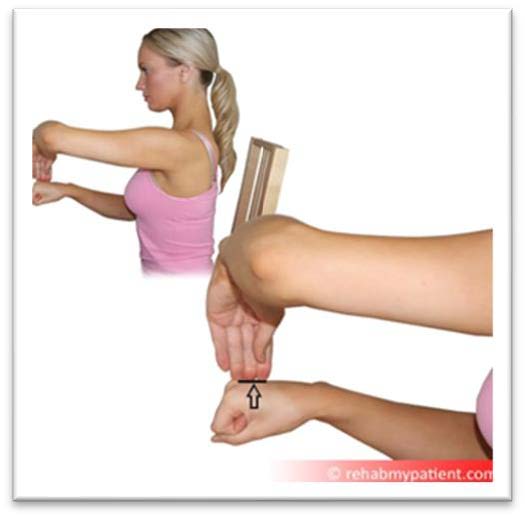
Exercise 3 - Resist bending your wrist
Isometric flexion - Resist bending your wrist
- You can do this by placing your affected hand straight out in front of you.
- Place your other hand below and resist the movement of your hand downwards.
- Repeat 10 times.
- Build up to 3 sets of 10.
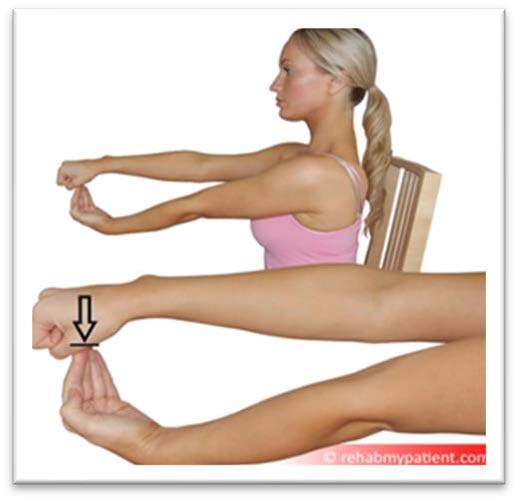
Exercise 4 - Rotation with stick
Rotation with stick
- Holding a stick in both hands with the palm facing downwards (first image) rotate the wrist outwards feeling an increase in pressure on the little finger.
- Repeat 10 times.
- Build up to 3 sets of 10.
- See second image, hold the stick in both hands with the palm facing upwards. Rotate the wrists inwards feeling the pressure on the thumbs.
- Repeat 10 times.
- Build up to 3 sets of 10.
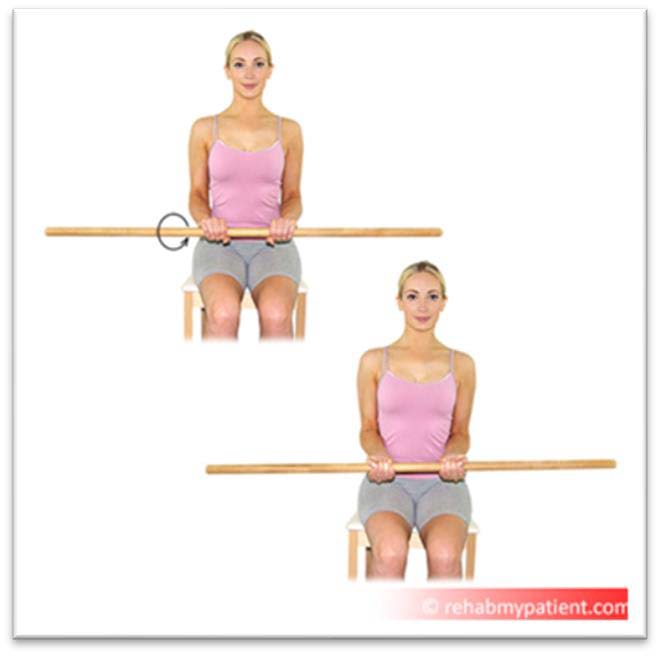
Images provided by RehabMyPatient- permission gained
What actions can I take to improve my health?
Evidence tells us that making healthy lifestyle choices can have a big impact on influencing problems with your muscles and bones and can play a major role in your overall health. Some of the most effective areas to address are below:
Maintaining a healthy weight - www.nhs.uk/live-well/healthy-weight/
Increasing levels of physical activity - http://www.nhs.uk/live-well/exercise/
Avoiding poor sleep patterns - www.nhs.uk/live-well/sleep-and-tiredness/how-to-get-to-sleep/
Reducing alcohol consumption - https://www.nhs.uk/live-well/alcohol-support/calculating-alcohol-units/
Stopping smoking - http://www.nhs.uk/live-well/quit-smoking/
Maintaining a healthy mind - http://www.nhs.uk/conditions/stress-anxiety-depression/
The good news is that you can influence lots of these by modifying your lifestyle. Therefore, it is important that you consider addressing these areas alongside your current treatment.
You may wish to discuss any of these factors with your treating clinician who will be able to work with you and guide your long- term management and support you to improve your wellbeing.
There will be information about the local services that exist within the waiting areas of the physiotherapy department and your treating clinician will be able to help signpost you to appropriate services.
There are some websites below that give more information on local services available:
• Blackburn and Darwen: https://refreshbwd.com/
• East Lancashire: http://www.upandactive.co.uk/
• Public Health England: https://www.gov.uk/government/organisations/public-health-england
Applications (Apps)
The ORCHA website will recommend useful and rated apps to support your wellbeing. https://www.orcha.co.uk/
Aims of Physiotherapy:
Physiotherapy may form one part of your management, helping you identify the main contributory factors whilst working together to plan your rehabilitation.
Your physiotherapist may spend time talking with you about your elbow pain, providing advice, reassurance and helping discuss any concerns you may have.
As mentioned previously, exercise is one of the most effective treatments for elbow pain.
A physiotherapist can provide and help oversee a personalised exercise programme focused on what you want and need your body to achieve.
Warning Signs
If you have severe pain which is getting worse over several weeks, if you are unwell, or under the age of 16 years, you should consult your doctor.
The following symptoms are very rare, but if you suddenly develop any of them, you should consult your doctor straightaway.
- Significant swelling to the arm
- Feeling generally unwell
- Sign of infection i.e. does your joint feel hot and swollen to touch compared to the other side, night sweats that are out of the ordinary, high temperature and feeling unwell.
- Constant night pain (unable to rest/sleep)
- Unexplained weight loss
- Loss of feeling such as numbness or pins and needles in your hand / wrist / arm
- Loss of control of hand movements or strength or grip (dropping objects)
If your symptoms fail to improve within six weeks with this regime you should contact your doctor for a physiotherapy referral.
You can download a printable version of this information here.
Please note this is a PDF and does not meet accessibility needs.


